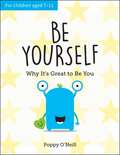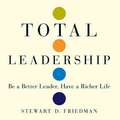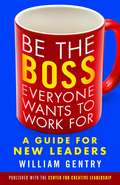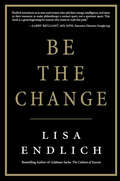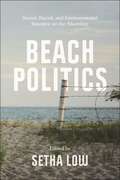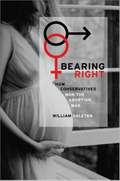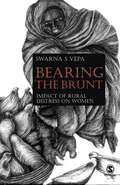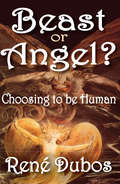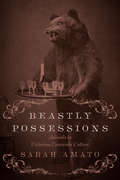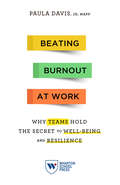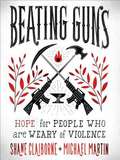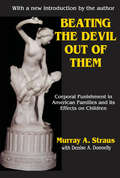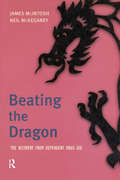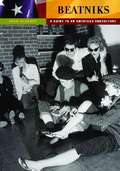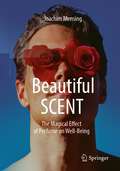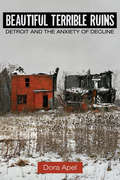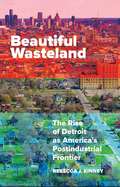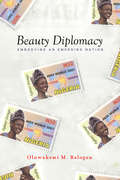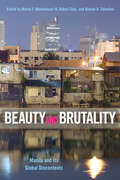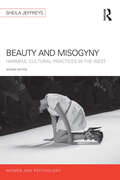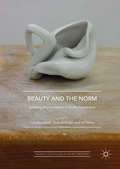- Table View
- List View
Be Yourself: Why It's Great to Be You: A Child's Guide to Embracing Individuality
by Poppy O'NeillThis practical guide for children aged 7–11 combines proven cognitive behavioural therapy methods and fun and engaging activities, which are interspersed with useful tips, inspirational statements and practical information for parents, to help your child build on their self-belief.
Be a Good Soldier
by Jennifer FraserIn the modern era, children experiencing grief were encouraged to dry their tears and 'be good soldiers.' How was this phenomenon interrogated and deconstructed in the period's literature? Be a Good Soldier initiates conversation on the figure of the child in modernist novels, investigating the demand for emotional suppression as manifested later in cruelty and aggression in adulthood.Jennifer Margaret Fraser provides sophisticated close readings of key works by Joseph Conrad, Virginia Woolf, and James Joyce, among others who share striking concerns about the concept of infantry -- both as a collection of infants, and as foot soldiers of war. A phenomenon associated traditionally with Freud, Fraser instead uses a unique, Derridean theoretical prism to provide new ways of understanding modernist concerns with power dynamics, knowledge, and meaning. Be a Good Soldier establishes a pioneering, nuanced vocabulary for further historical and cultural inquiries into modernist childhood.
Be my neighbor
by Maya Ajmera, John D. IvankoA simple introduction to the characteristics of a neighborhood.
Be the Boss Everyone Wants to Work For: A Guide for New Leaders
by William A. GentryFlip Your Script!You've been promoted to leadership--congratulations! But it's nothing like your old job, is it? William Gentry says it's time to flip your script. We all have mental scripts that tell us how the world works. Your old script was all about "me": standing out as an individual. But as a new leader, you need to flip your script from "me" to "we" and help the group you lead succeed. In this book, Gentry supports and coaches you to flip your script in six key areas. He offers actionable, practical, evidence-based advice and examples drawn from his research, his work with leaders, and his own failures and triumphs of becoming a new leader. Get started flipping your script and become the kind of boss everyone wants to work for.
Be the Change: Candid Conversations with the World's Most Successful Philanthropists
by Lisa EndlichMeet the men and women whose deeply personal philanthropy is dramatically changing the way we think about givingThere are 8.6 million millionaires in the United States, and these numbers are set to rise in what will be the biggest intergenerational wealth transfer in history. As $41 trillion dollars (or over three times the national GDP) moves from the World War II generation to their baby- boomer children over the next couple of decades, it will become imperative that the beneficiaries of this wealth—even those not joining the ranks of the superrich—begin thinking about philanthropy, perhaps for the first time in their adult lives. Here they will find the personal journeys of the most successful givers of their generation. This new generation of wealth has already begun to change the face of philanthropy and to reshape the entire nonprofit sector. In Be the Change, bestselling author Lisa Endlich presents eleven compelling profiles of this twenty-first century generosity. Through candid, revealing, and often surprising interviews, readers will venture into the hearts and minds of the top names in philanthropy today—men and women who have chosen to use their immense riches and influence to meaningfully improve the lives of others in the most dramatic ways. These intimate conversations include in-depth interviews with:Melinda Gates, one of the driving forces behind the largest philanthropic organization the world has ever seen;Bob and Suzanne Wright, he's the former vice chairman of GE and longtime head of NBC Universal and their Autism Speaks has brought awareness of autism onto the national and international stage; Paul Tudor Jones, founder of Tudor Investments and the Robin Hood Foundation;Peter Bloom, founding chairman of the groundbreaking DonorsChoose.org.From Connie Duckworth, a former Goldman Sachs partner, who brings steady employment to Afghani women and education to them and their children, to Johann Olav Koss, an Olympic gold medalist who now strives to give children in the direst circumstances the chance to play, these philanthropists demonstrate that giving doesn't begin or end with a signed check. They grant Endlich exclusive access to the stories of how they learned from early failures and developed a personal, sustainable way of giving, and they also share the catalyzing moment when they saw a problem so heartbreaking they simply could not turn away. In doing so, these new philanthropists offer valuable lessons—ones that will inspire readers to start giving, keep giving, and become the change they want to see in the world.
Beach Politics: Social, Racial, and Environmental Injustice on the Shoreline
by Setha LowExplores how elites restrict access to public beaches around the globeBeaches are a beloved form of public space. Yet there has been an alarming global trend of restricting access to public sections of beaches to ensure that waterfront property owners can enjoy the shoreline exclusively or develop the land for commercial use.Beach Politics examines how over the past forty years, privatization of public space has accelerated with the help of both local governments and national corporations. On a local level, this can entail a group of wealthy neighbors purposely blocking off public beach access in their neighborhood: hiring security guards, building fences, or putting up “No Trespassing” signs to turn away members of the public who have every right to be there. On a state or national level, it can manifest as gated communities owned by private corporations sectioning off huge swaths of land, limiting access, or governments promoting private, rather than public, development along the shoreline. Whenever disputes about land use arise, the powers that be often side with private interests and the wealthy over those with fewer resources and, frequently, people of color. With the continuing threat of climate change, decisions about how and where to harden or protect the shoreline often limits public use.Focused on beaches, access to public space, and social justice, this book brings together powerful contributions illustrating how these issues are inextricably bound with socioeconomic status, racial segregation, and climate justice. Together they highlight how, through illegal actions and exclusionary legislation, the beach can be transformed from “a strip of nature” into a palimpsest of greed, racism, ecological disregard, and socioeconomic discrimination.
Bearing Right: How Conservatives Won the Abortion War
by William SaletanIn his gripping, behind-the-scenes account, journalist William Saletan reveals exactly how, thirty years after Roe v. Wade, "pro-choice" conservatives have won the abortion war.
Bearing the Brunt: Impact of Rural Distress on Women
by Swarna S VepaThis book refutes the rising general perception that the gender gap in India is decreasing. The argument is strengthened by calculating the gender gap index at two time periods and providing quantitative information along with information pertaining to numerous case studies. Selecting relevant welfare indicators and focusing on the neglected dimensions of gender equity, Bearing the Brunt: Impact of Rural Distress on Women discusses the gendered impact of rural economic distress with respect to employment, agricultural production, natural resource management and food security. It shows that women are bearing the brunt of the increase in rural economic distress at the turn of the century, with spillover effects on their physical and social wellbeing. The gender gap index shows a widening of the gender gap in welfare between mid-nineties and this decade. The discourse is based on official statistics obtained mainly from the National Sample Survey and the Census of India. This book will be an excellent reference source for researchers working in the fields of development economics, health, education and welfare economics and gender studies. It will also add value to the programmes of government departments, NGOs, and other institutions that are working in the fields of women and child welfare, rural development, equitable growth and gender parity.
Beast or Angel?: Choosing to be Human
by Rene DubosThe world of things is different now from what it was half a century ago, but Rene Dubos doubts that there have been basic changes in life itself, in those attitudes and activities, needs, and yearning, that are the most important for happiness and suffering, for hope and despair the differences between humanity and animality. Sophisticated and civilized as we may be, we have retained from our distant ancestors the ability to derive profound satisfaction from the small happenings of daily life.Beast or Angel? attempts to trace the origins of needs and yearnings that have always been those of humankind everywhere and always. In this search, Dubos expresses the same concerns and uses the same words when speaking of the past, the present, or the future the reason being that the biological and psychological characteristics of humankind have remained essentially the same for at least fifty millennia.We are human to the extent that we live according to certain principles which have a human quality. This quality has emerged and continues to emerge from the choices that we make throughout our individual lives and that humankind has made from the beginning of its existence. To be human is to be able and willing to choose among the options that are offered to the human species by the natural order of things. This book examines human species, not only on the basis of the biological and psychological attributes it shares with animal species, but more by identifying its choices throughout pre-history and history.
Beastly Possessions
by Sarah AmatoIn Beastly Possessions, Sarah Amato chronicles the unusual ways in which Victorians of every social class brought animals into their daily lives. Captured, bred, exhibited, collected, and sold, ordinary pets and exotic creatures - as well as their representations - became commodities within Victorian Britain's flourishing consumer culture.As a pet, an animal could be a companion, a living parlour decoration, and proof of a household's social and moral status. In the zoo, it could become a public pet, an object of curiosity, a symbol of empire, or even a consumer mascot. Either kind of animal might be painted, photographed, or stuffed as a taxidermic specimen.Using evidence ranging from pet-keeping manuals and scientific treatises to novels, guidebooks, and ephemera, this fascinating, well-illustrated study opens a window into an underexplored aspect of life in Victorian Britain.
Beating Burnout at Work: Why Teams Hold the Secret to Well-Being and Resilience
by Paula DavisA first-of-its-kind, science-backed toolkit takes a holistic approach to burnout prevention by helping individuals, teams, and leaders build resilience and thrive at work.Burnout has become one of the most talked about workplace topics, and its impact is far-reaching. The 24/7 pace of work, constant demands, and scant resources can easily put busy professionals on a path to burnout, a cycle that has only accelerated during the COVID-19 pandemic. Burnout affects the health and well-being of the entire organization, yet most attempts to help focus on quick-fix strategies aimed at individuals. Something is missing.In Beating Burnout at Work: Why Teams Hold the Secret to Well-Being and Resilience, Paula Davis, founder of the Stress & Resilience Institute, provides a new framework to help organizations prevent employee burnout.Davis's research-driven, fast-reading, and actionable book is the first of its kind to explore a new solution to the burnout problem at work: a comprehensive approach focused on building the resilience of teams of all sizes. Davis argues that teams, and their leaders, are uniquely positioned to create the type of cultures that are needed to prevent burnout.In Beating Burnout at Work, Davis shares stories from her work coaching, teaching, and training leaders and teams of all sizes, and she explores:How she navigated her own burnout as a lawyer, and how that led her to study burnout and launch a business with the aim of helping organizations and their employees become more resilient; How teams and leaders can utilize simple, science-backed strategies to create cultures that promote resilience and well-being and reduce burnout; How the Mayo Clinic, one of the most renowned medical centers in the world, has developed a powerful model to reduce burnout in its organization; How organizations dealing with high-stress challenges, including the US Army, work to increase resilience in a systemic way; andHow the German company trivago is piloting a new approach to work amid COVID-19 in order to increase team connection and resilience.Solving the burnout puzzle requires a systemic approach. In Beating Burnout at Work, Davis offers an actionable method to help leaders create cultures of well-being and resilience in their organizations.
Beating Guns: Hope for People Who Are Weary of Violence
by Shane Claiborne Michael MartinParkland. Las Vegas. Dallas. Orlando. San Bernardino. Paris. Charleston. Sutherland Springs. Newtown. These cities are now known for the people who were shot and killed in them. More Americans have died from guns in the US in the last fifty years than in all the wars in American history. With less than 5% of the world's population, the people of the US own nearly half the world's guns. America also has the most annual gun deaths--homicide, suicide, and accidental gun deaths--at 105 per day, or more than 38,000 per year. Some people say it's a heart problem. Others say it's a gun problem. The authors of Beating Guns believe it's both. <P><P> This book is for people who believe the world doesn't have to be this way. Inspired by the prophetic image of beating swords into plows, Beating Guns provides a provocative look at gun violence in America and offers a clarion call to change our hearts regarding one of the most significant moral issues of our time. Bestselling author, speaker, and activist Shane Claiborne and Michael Martin show why Christians should be concerned about gun violence and how they can be part of the solution. The authors transcend stale rhetoric and old debates about gun control to offer a creative and productive response. Full-color images show how guns are being turned into tools and musical instruments across the nation. Charts, tables, and facts convey the mind-boggling realities of gun violence in America, but as the authors make clear, there is a story behind every statistic. Beating Guns allows victims and perpetrators of gun violence to tell their own compelling stories, offering hope for change and helping us reimagine the world as one that turns from death to life, where swords become plows and guns are turned into garden tools.
Beating the Devil Out of Them: Corporal Punishment in American Children
by Valerie BentzBased on his studies of over 9,000 families, Murray A. Straus, the foremost researcher on family violence in the world, discusses the extent to which parents in the United States use corporal punishment (such as spanking and slapping) and its effects on their chil-dren. The question of whether corporal punishment is an effective method of discipline is hotly debated. Straus contends that this believed-to-be-"minor" form of physical violence is precursor to much violence that plagues our world.Children who are spanked quickly learn that love and violence can go hand in hand. Since spanking is generally done by loving, caring parents for the child's own good a child can learn that hitting is "morally right." Straus describes what he has learned through two decades of research: children who are spanked are from two to six times more likely to be physically aggressive, to become juvenile delinquents, and later, as adults, to use physical violence against their spouses, to have sadomasochistic tendencies, and to suffer from depression. Straus alerts parents to these risks, and argues that spanking adversely affects not only the children who are subjected to it but society as a whole.This groundbreaking book, now available in paperback with a substantive new introduction and new concluding chapter, is essential reading for parents as well as teachers, lawyers, and judges. Professionals in fields such as social work, child protection, delin-quency and criminology, psychology, and politics will find it of critical importance.
Beating the Dragon: The Recovery from Dependent Drug Use
by James McIntoshSuitable for 2nd and 3rd year students taking courses on drug use/misuse principally in departments such as Sociology, Law, Cultural and Media Studies, and Psychology. Also particularly relevant for students taking courses leading to a profession, such as nurses and social workers. The use of illegal drugs is widespread in many societies. Within many western societies particular concern has been focused on the nature and extent of illegal drug use amongst young people. In much of the media coverage an impression is often conveyed that the use of illegal drugs other than cannabis is a one way street leading inevitably to addiction, destitution, family breakdown and death. This impression fails to grasp the fact that most drug users do not become addicts and most addicts do not die. The perception of addiction as a fixed end point characterised by personal and social dissolution fails to recognise that many dependent drug users, even after a period of prolonged dependent drug use, nevertheless still manage to overcome their dependence upon illegal drugs. This process of recovery, either with or without the assistance of helping agencies, has been variously described by researchers, drug counsellors, clinicians and others.
Beating the Workplace Bully: A Tactical Guide to Taking Charge
by Lynne CurryWhether you&’re the target of manipulation, intimidation, verbal abuse, or deliberate humiliation, Beating the Workplace Bully will show you how to fight back.Bullies aren&’t just limited to the playground. Now they roam around from the boardroom to the break room looking to manipulate, intimidate, and humiliate--and eventually ruin your career! This book is your ammunition for fighting back.Whether the bully is a boss or a coworker, this empowering guide will help you recognize what has been causing you to become a victim, then reveals how to:Avoid typical bully trapsRemain aware and in chargeMove past your fearCalm yourself in any confrontationKeep your dignity intacHandle sneak attacksCombat cyberbullyingComplete with exercises, assessments, and real-life examples, Beating the Workplace Bully will help you reclaim your power and defeat the office bully once and for all!
Beatniks: A Guide To An American Subculture
by Alan BisbortA historian of American culture and art, Bisbort profiles the first counter-culture generation to be branded by modern marketing. He describes the origins of the beat generation during World War II, how the beats turned into beatniks, the emergence of a beatnik voice, and the spread of the phenomenon from Manhattan to the US and the world. Support material includes a timeline, biographical sketches, a glossary, lists of movies and magazines, and lists of precursors and progeny. Annotation c2010 Book News, Inc., Portland, OR (booknews.com)
Beautiful SCENT: The Magical Effect of Perfume on Well-Being
by Joachim MensingThis book will make you a perfume insider. Discover the effects, trends and future of perfume. Perfumery is on the verge of its third revolution, neuroperfumery, due to new methods of brain research and current findings in fragrance psychology.With this exciting and well-written book, you will gain a comprehensive insight into the creation, world and practice of modern perfumery, as well as interesting insider information. Current findings in psychology, aromatherapy, brain research and neuroperfumery on the effects of fragrances make Beautiful SCENT a treasure trove of new insights. As a non-fiction book with an advice component, it is easy to read without prior knowledge and provides many practical tips. Among other things, you will learn that some perfumes can do much more than just smell good, how perfumers and marketers create their perfumes, which scent preferences prevail and how the effect of scent can specifically influence one's own experience and enjoyment of life. Target groupsAll those who love perfumes and fragrances and would like to learn more about the magical effect of perfumes on well-being and perhaps play with the idea of creating their own perfume one day. It is also ideal for those who work in the fragrance, cosmetics and beauty industry and would like to refresh their knowledge of perfumes. About the authorDr. Joachim Mensing is a qualified psychologist, sociologist and trained nose with over 30 years of professional experience in perfumery and fragrance therapy. At one of the largest fragrance manufacturers, he became a trend coach for perfumers and developed methods of perfume development and marketing. Many of the perfumes he worked on received coveted awards such as the Fifi Award, the Oscar for perfumes. He himself received the honorary award of the FRAGRANCE FOUNDATION for the development and marketing of the perfumes Cool Water by Davidoff, Joop! and Jil Sander, and he was also recognized for studies in neuroperfumery and neuropsychology.
Beautiful Terrible Ruins
by Dora ApelOnce the manufacturing powerhouse of the nation, Detroit has become emblematic of failing cities everywhere--the paradigmatic city of ruins--and the epicenter of an explosive growth in images of urban decay. In Beautiful Terrible Ruins, art historian Dora Apel explores a wide array of these images, ranging from photography, advertising, and television, to documentaries, video games, and zombie and disaster films. Apel shows how Detroit has become pivotal to an expanding network of ruin imagery, imagery ultimately driven by a pervasive and growing cultural pessimism, a loss of faith in progress, and a deepening fear that worse times are coming. The images of Detroit's decay speak to the overarching anxieties of our era: increasing poverty, declining wages and social services, inadequate health care, unemployment, homelessness, and ecological disaster--in short, the failure of capitalism. Apel reveals how, through the aesthetic distancing of representation, the haunted beauty and fascination of ruin imagery, embodied by Detroit's abandoned downtown skyscrapers, empty urban spaces, decaying factories, and derelict neighborhoods help us to cope with our fears. But Apel warns that these images, while pleasurable, have little explanatory power, lulling us into seeing Detroit's deterioration as either inevitable or the city's own fault, and absolving the real agents of decline--corporate disinvestment and globalization. Beautiful Terrible Ruins helps us understand the ways that the pleasure and the horror of urban decay hold us in thrall.
Beautiful Wasteland: The Rise of Detroit as America's Postindustrial Frontier
by Rebecca J. KinneyAccording to popular media and scholarship, Detroit, the once-vibrant city that crumbled with the departure of the auto industry, is where dreams can be reborn. It is a place that, like America itself, is gritty and determined. It has faced the worst kind of adversity, and supposedly now it&’s back. But what does this narrative of &“new Detroit&” leave out? Beautiful Wasteland reveals that the contemporary story of Detroit&’s rebirth is an upcycled version of the American Dream, which has long imagined access to work, home, and upward mobility as race-neutral projects. They&’re not. As Rebecca J. Kinney shows, the narratives of Detroit&’s rise, decline, and potential to rise again are deeply steeped in material and ideological investments in whiteness. By remapping the narratives of contemporary Detroit through an extension of America&’s frontier mythology, Kinney analyzes a cross-section of twentieth and twenty-first century cultural locations—an Internet forum, ruin photography, advertising, documentary film, and print and online media. She illuminates how the stories we tell about Detroit as a frontier of possibility enable the erasure of white privilege and systemic racism. By situating Detroit as a &“beautiful wasteland,&” both desirable and distressed, this shows how the narrative of ruin and possibility form a mutually constituted relationship: the city is possible precisely because of its perceived ruin.Beautiful Wasteland tackles the key questions about the future of postindustrial America. As cities around the country reckon with their own postindustrial landscapes, Rebecca Kinney cautions that development that elides considerations of race and class will only continue to replicate uneven access to the city for the poor, working class, and people of color.
Beauty Diplomacy: Embodying an Emerging Nation (Globalization in Everyday Life)
by Oluwakemi M. BalogunEven as beauty pageants have been critiqued as misogynistic and dated cultural vestiges of the past in the US and elsewhere, the pageant industry is growing in popularity across the Global South, and Nigeria is one of the countries at the forefront of this trend. In a country with over 1,000 reported pageants, these events are more than superficial forms of entertainment. Beauty Diplomacy takes us inside the world of Nigerian beauty contests to see how they are transformed into contested vehicles for promoting complex ideas about gender and power, ethnicity and belonging, and a rapidly changing articulation of Nigerian nationhood. Drawing on four case studies of beauty pageants, this book examines how Nigeria's changing position in the global political economy and existing cultural tensions inform varied forms of embodied nationalism, where contestants are expected to integrate recognizable elements of Nigerian cultural identity while also conveying a narrative of a newly-emerging, globally-relevant Nigeria. Oluwakemi M. Balogun critically examines Nigerian pageants in the context of major transitions within the nation-state, using these events as a lens through which to understand Nigerian national identity and international relations.
Beauty Technology: Designing Seamless Interfaces for Wearable Computing (Human–Computer Interaction Series)
by Katia Vega Hugo FuksThe increasing advances in electronics allows smaller and more powerful devices, bringing wearable computing closer to reality. However, most wearable computers are very distinguished and placed on clothes and accessories. This book tries to tackle this phenomenon by introducing a new wearable computing subfield called beauty technology. By using the body's surface as an interactive platform, the integration of technology into beauty products is explored and can be applied directly to ones skin, fingernails, and hair adding new functionality to beauty products using technology in a personal, seamless and fashionable way. An interdisciplinary approach is taken, exploring the design of Beauty Technologies such as Conductive Makeup, Tech Nails, Hairware and FX e-makeup in order to create novel interfaces for Human Computer Interaction.
Beauty and Brutality: Manila and Its Global Discontents
by Martin F. Manalansan IV, Robert Diaz, and Rolando B. TolentinoBeauty and Brutality provides an exciting, original, and critical encounter with this labyrinthine city’s imagined and material landscape. The authors and contributors investigate the “messy, fleshy, recalcitrant, mercurial, and immeasurable qualities of the city,” examining its urban space and smell: how it is represented in films, literature, music, and urban streetart; how it has endured the politics of colonialism, U.S. imperialism, neoliberalism, and globalization; as well as how its queer citizens engage with digital media platforms to communicate and connect with each other. The first volume to offer a cultural and urban studies approach to Manila, Beauty and Brutality considers the tensions of the Filipino diaspora as they migrate and “re-turn,” as well as the citizens’ responses to the Marcos (and post-Marcos) dictatorship, President Duterte’s authoritarianism, and “Drug War.” Essays also map out of geographies of repression and resistance in the urban war of classes, genders and sexualities, ethnicities and races, and generations, along with the violence of urban life and growth. Ultimately, Beauty and Brutality frames Manila as a vibrant and ever-evolving metropolis that, even in the face of its difficulties, instills hope. Contributors: Paul Michael Leonardo Atienza, Christine Bacareza Balance, Vanessa Banta, Rosa Cordillera A. Castillo, Roland Sintos Coloma, Gary C. Devilles, Faith R. Kares, John B. Labella, Raffy Lerma, Bliss Cua Lim, Ferdinand M. Lopez, Paul Nadal, Jema M. Pamintuan, Oscar Tantoco Serquiña, Jr., Louise Jashil R. Sonido, and the editors.
Beauty and Misogyny: Harmful cultural practices in the West (Women and Psychology)
by Sheila JeffreysThe new edition of Beauty and Misogyny revisits and updates Sheila Jeffreys' uncompromising critique of Western beauty practice and the industries and ideologies behind it. Jeffreys argues that beauty practices are not related to individual female choice or creative expression, but represent instead an important aspect of women's oppression. As these practices have become increasingly brutal and pervasive, the need to scrutinize and dismantle them is if anything more urgent now as it was in 2005 when the first edition of the book was published. The United Nations concept of "harmful traditional/cultural practices" provides a useful lens for the author to advance her critique. She makes the case for including Western beauty practices within this definition, examining their role in damaging women's health, creating sexual difference and enforcing female deference. First-wave feminists of the 1970s criticized pervasive beauty regimes such as dieting and depilation, but a later argument took hold that beauty practices were no longer oppressive now that women could "choose" them. In recent years the reality of Western beauty practices has become much more bloody and severe, requiring the breaking of skin and the rearrangement or amputation of body parts. Beauty and Misogyny seeks to make sense of why beauty practices have not only persisted but become more extreme. It examines the pervasive use of makeup, the misogyny of fashion and high-heeled shoes, and looks at the role of pornography in the creation of increasingly popular beauty practices such as breast implants, genital waxing, surgical alteration of the labia and other forms of self-mutilation. The book concludes by considering how a culture of resistance to these practices can be created. A new and thoroughly updated edition of this essential work will appeal to all levels of students and teachers of gender studies, cultural studies and feminist psychology, and to anyone with an interest in feminism, women and beauty, and women's health.
Beauty and the Norm: Debating Standardization In Bodily Appearance (Palgrave Studies In Globalization And Embodiment Ser.)
by Claudia Liebelt Sarah Böllinger Ulf VierkeRecent decades have seen the rise of a global beauty boom, with profound effects on perceptions of bodies worldwide. Against this background, Beauty and the Norm assembles ethnographic and conceptual approaches from a variety of disciplines and across the globe to debate standardization in bodily appearance. Its contributions range from empirical research to exploratory conversations between scholars and personal reflections. Bridging hitherto separate debates in critical beauty studies, cultural anthropology, sociology, the history of science, disability studies, gender studies, and critical race studies, this volume reflects upon the gendered, classed, and racialized body, normative regimes of representation, and the global beauty economy.
